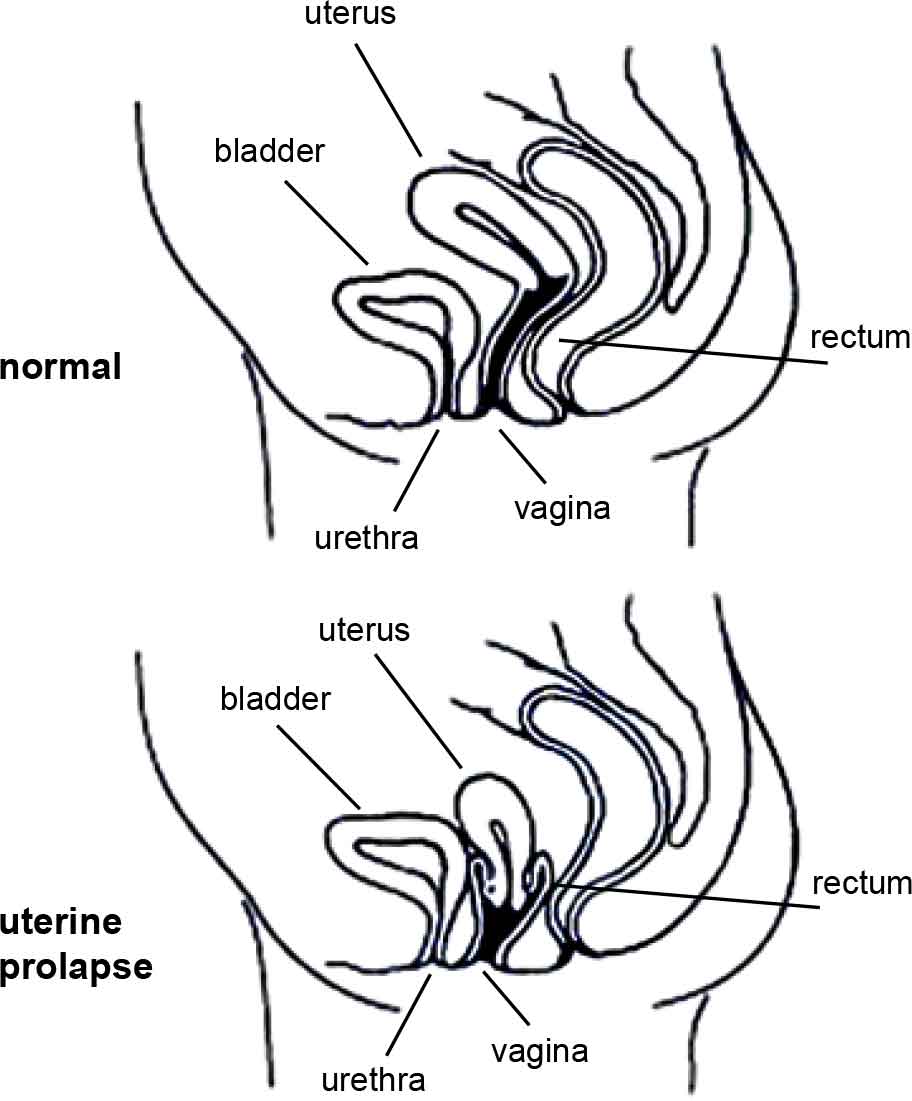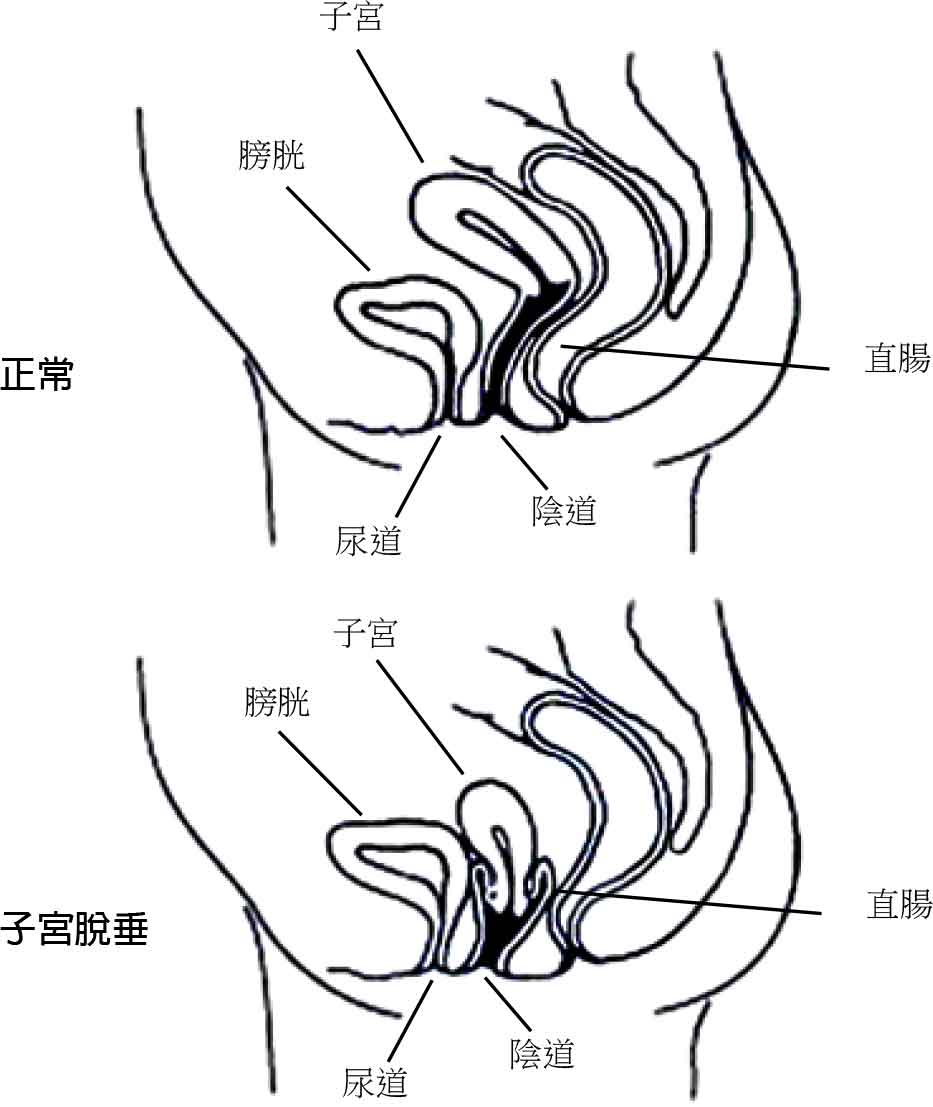What is a vaginal (or pelvic organ) prolapse?Your pelvic organs include your bladder, uterus (womb) and rectum (back passage). These organs are held in place by tissues called “fascia” and “ligaments”. These tissues help to join your pelvic organs to the bony side walls of the pelvis and hold them inside your pelvis. Your pelvic floor muscles also hold up your pelvic organs from below. If the fascia and ligaments are torn or stretched for any reason, and if your pelvic floor muscles are weak, then your pelvic organs (your bladder, uterus, or rectum) might not be held in their right place and they may bulge down into the vagina (birth canal). | 什么是阴道(或盆腔器官)下垂?盆腔器官包括膀胱、子宫及直肠(肛门)。这些器官由被称为“筋膜”及“韧带”的组织固定位置。这些组织帮助将盆腔器官连接到骨盆壁上,从而将它们保持在盆骨内。骨盆底肌肉也将盆腔器官托起。如果筋膜及韧带因某种原因被撕裂或拉伤,而且如果骨盆底肌肉无力,盆腔器官(膀胱、子宫或直肠)或不能保持在适当位置而坠入阴道(产道)内。 |
What are the signs of prolapse?There are a few signs that you may have a prolapse. These signs depend on the type of prolapse and how much pelvic organ support has been lost. Early on, you may not know you have a prolapse, but your doctor or nurse might be able to see your prolapse when you have your routine Pap test. When a prolapse is further down, you may notice things such as:
These signs can be worse at the end of the day and may feel better after lying down. If the prolapse bulges right outside your body, you may feel sore and bleed as the prolapse rubs on your underwear.
| 盆腔器官下垂有哪些征兆?有一些征兆显示你可能有盆腔器官下垂。这些征兆取决于下垂的类型以及盆腔器官失去支撑的程度。最初你可能不知道自己有下垂,但医生或护士替你做常规子宫颈抹片检查时可能会看见下垂的器官。 当器官进一步下垂时,你可能会留意到下列征兆:
这些征兆晚上可能会更严重,而躺下之后会感觉好一点。如果下垂器官突出体外,在它摩擦内裤时你会感到疼痛并会出血。
|
What causes prolapse?The pelvic organs are held inside the pelvis by strong healthy fascia. They are held up from below by pelvic floor muscles that work like a firm muscle sling. If the support tissues (fascia and ligaments) that keep the bladder, uterus and bowel in place inside the pelvis are weak or damaged, or if the pelvic floor muscles are weak and saggy, then prolapse can happen. Childbirth is the main cause of prolapse. On the way down the vagina, the baby can stretch and tear the support tissues and the pelvic floor muscles. The more vaginal births you have, the more likely you are to have a prolapse. | 下垂的成因?盆腔器官由强健的筋膜保持在盆腔内,并由像牢固的肌肉吊索一样的骨盆底肌肉将其托起。如果在盆骨内固定膀胱,子宫及直肠的支撑组织(筋膜及韧带)无力或受损,或者如果骨盆底肌肉无力及松弛,就会出现下垂。 分娩是下垂的主要原因。胎儿沿着阴道往下时,会拉扯及撕裂支撑组织及骨盆底肌肉。你经历的分娩次数越多,出现下垂的可能性就越大。 |
Other things that press down on the pelvic organs and the pelvic floor muscles that can lead to prolapse, are:
| 其它压迫盆腔器官及骨盆底肌肉并会引起下垂的因素包括:
|
Types of prolapsePelvic organs may bulge through the front wall of the vagina (called a cystocele [sist-o-seal]), through the back vaginal wall (called a rectocele [rec-to-seal] or an enterocele (enter-o-seal]) or the uterus may drop down into your vagina (uterine prolapse). More than one organ may bulge into the vagina. | 下垂的类型盆腔器官会向阴道前壁突出(称为膀胱突出症),向阴道后壁突出(称为直肠突出或阴道后疝),或子宫落入阴道内(子宫脱垂)。可能会有不止一个器官下垂入阴道内。 |
Who is likely to have a prolapse?Prolapse tends to run in families. It is more likely after menopause or if you are overweight. But it can happen in young women right after having a baby.
| 哪些人有可能出现下垂?下垂往往有家族性。绝经之后或身体肥胖时更有可能出现,但也可能出现在刚刚生完孩子的年轻女性身上。
|
What can be done to help prevent prolapse?It is much better to prevent prolapse than try to fix it! If any women in your close family have had a prolapse, you are more at risk and you need to try very hard to follow the advice given here. As prolapse is due to weak pelvic tissues and pelvic floor muscles, you need to keep your pelvic floor muscles strong no matter what your age. Pelvic floor muscles can be made stronger with proper training (See the brochure “Pelvic Floor Muscle Training for Women”). It is important to have your pelvic floor muscle training checked by an expert such as a pelvic floor physiotherapist or a continence nurse advisor. If you have been told you have a prolapse, these experts are the best people to help plan a pelvic floor muscle training program to suit your needs. | 可以做些什么来预防下垂?预防下垂比设法治疗好得多!如果你的近亲家庭中有任何女性曾经患下垂,你的风险就更高,需要尽可能按照这里提出的建议去做。 由于下垂的起因是骨盆组织及骨盆底肌肉乏力,无论你是什么年龄,都需要保持骨盆底肌肉强健。 骨盆底肌肉可以通过适当的锻炼而强健(请参阅资料册“女性骨盆底肌肉锻炼”)。重要的是,要请骨盆底理疗师或排便科护士等专家检查你的骨盆底肌肉锻炼方法。如果你已得知自己有下垂,这些专家是帮你制订一个适合你所需的骨盆底肌肉锻炼计划的最佳人选。 |
What can be done to treat prolapse once it has happened?Prolapse can be dealt with simply or with surgery—it depends on the level of prolapse. The simple approach Prolapse can often be treated without surgery, chiefly in the early stages, and when the prolapse is mild. The simple approach can mean:
The surgery approach Surgery can be done to repair the torn or stretched fascia and ligaments. Surgery can be done through the vagina or the tummy. Sometimes special mesh is placed into the front or the back vaginal wall to strengthen it where it is weak or torn. As the body heals, the mesh helps form stronger tissues to give more support where it is needed. After surgery To prevent the prolapse coming back again, you should make sure you:
The diagrams have been reprinted with kind permission from Women’s Health Queensland Wide’s Genital Prolapse factsheet. | 一旦出现下垂,可以做些什么治疗?下垂可以通过简单方法或手术进行处理—取决于下垂的程度。 简单方法 对下垂的治疗通常无需手术,主要是在早期以及下垂轻微时进行。简单方法是指:
手术方法 可以通过阴道或腹部手术修复被撕裂或拉伤的筋膜及韧带。有时会将特制的网放入阴道前壁或后壁来增强薄弱或被撕裂的地方。随着身体康复,网能帮助形成较结实的组织,在所需地方提供较强的支撑。 手术之后 为了预防下垂复发,你要确保:
图表获授权,取自昆士兰州妇女健康服务(Women’s Health Queensland Wide)的生殖器脱垂事实说明。 |
Seek helpQualified nurses are available if you call the National Continence Helpline on 1800 33 00 66* (Monday to Friday, between 8.00am to 8.00pm Australian Eastern Standard Time) for free:
If you have difficulty speaking or understanding English you can access the Helpline through the free Telephone Interpreter Service on 13 14 50. The phone will be answered in English, so please name the language you speak and wait on the phone. You will be connected to an interpreter who speaks your language. Tell the interpreter you wish to call the National Continence Helpline on 1800 33 00 66. Wait on the phone to be connected and the interpreter will assist you to speak with a continence nurse advisor. All calls are confidential. * Calls from mobile telephones are charged at applicable rates. | 寻求帮助如果你致电国家排便节制热线,有资质的护士会接听你的电话1800 33 00 66*(周一至周五,澳大利亚东部标准时间8:00am—8:00pm)。
如果你在讲英语或者理解上有困难,你可以通过拨打13 14 50获取免费电话传译服务以接通国家排便节制热线。电话会用英语接通,因此请说明你要讲的语言并且不要挂机。你会被连接到一个讲你母语的传译员。告知传译员你想要致电国家排便节制热线,电话是1800 33 00 66。待电话接通后传译员会帮助你与排便节制护理顾问对话,所有的来电均保密。 * 用手机打出会收取相应费用。 |
Prolapse in Mandarin
盆腔器官下垂
Browse and download our factsheets in Mandarin
Last Updated: Fri 02, Jun 2023
Last Reviewed: Tue 17, Mar 2020



